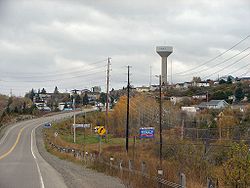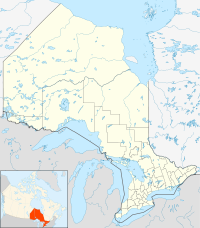- Cobalt, Ontario
-
Cobalt — Town — Nickname(s): Silver City Coordinates: 47°24′N 79°41′W / 47.4°N 79.683°WCoordinates: 47°24′N 79°41′W / 47.4°N 79.683°W Country  Canada
CanadaProvince  Ontario
OntarioDistrict Timiskaming District Established Government - Mayor André Bélanger - Governing Body Cobalt Town Council - MPs Jay Aspin (CPC) - MPPs David Ramsay (OLP) Area[1] - Land 2.11 km2 (0.8 sq mi) Population (2006)[1][2] - Total 1,223 - Density 579.6/km2 (1,501.2/sq mi) Time zone EST (UTC-5) - Summer (DST) EDT (UTC-4) Postal code P0J 1C0 Area code(s) 705 Website www.cobalt.ca Cobalt is a town in the district of Timiskaming, province of Ontario, Canada, with a population of 1,223 (as per the Canada 2006 Census.)
In 2001 Cobalt was named "Ontario's Most Historic Town" by a panel of judges on the TV Ontario program Studio 2, and in 2002 the area was designated a National Historic Site.
Contents
History
Silver was discovered in the area in the summer of 1903, during the construction of the Temiskaming & Northern Ontario Railway from North Bay to the communities of Haileybury and New Liskeard, north of Cobalt. Within a few years the area was one of the largest silver producing areas in the world. Speculation over mining stocks led to riots on Wall Street in New York City. The town was incorporated in 1906. Its population swelled and peaked at 7,000. In 1911, silver production exceeded 30,000,000 ounces (937.5 tons). Mining continued until the 1930s, then slowed to a trickle. Activity renewed in the 1950s then slowly dropped off, and there are no longer any operating mines in the area. However, one mill still operates in the area, and there continues to be exploration, including exploration for diamonds.
The silver mines of Cobalt, and the prospectors and miners that discovered them and worked the mines, have left an indelible mark on Canadian history, and the town is known as the birthplace of hard rock mining in Canada. The ore in Cobalt was close to surface, which meant that men with limited experience could prospect and begin mining, and then hone their skills as the mines went deeper. Those who learned their trade in Cobalt moved north, discovering gold in Kirkland Lake and Timmins and further afield in Canada and around the world. The mining in Cobalt was done with the use of wheelbarrows, pickaxes, hand steel and dynamite.
The Cobalt Silver Kings played in the inaugural 1910 NHA season.
Cobalt, Haileybury, and New Liskeard were formerly known as the Tri-Towns. When Haileybury and New Liskeard were amalgamated into the city of Temiskaming Shores in 2004, Cobalt decided to remain a separate town. However, the two municipalities continue to have a close relationship, including the operation of a shared public transit system.
Also noteworthy is that in 2001 the town voted overwhelmingly to stop adding fluoride to the drinking water.
Demographics
Census Population 1911 5,638 1921 4,449 1931 3,885 1941 2,376 1951 2,230 1961 2,209 1971 2,197 1981 1,759 1991 1,470 1996 1,401 2001 1,229 2006 1,223 Private dwellings occupied by usual residents: 532 (total dwellings: 569)
Mother tongue:[1]
- English as first language: 76.0 %
- French as first language: 19.5 %
- English and French as first language: 2.0%
- Other as first language: 2.4 %
Environmental issues
The mining activities in Cobalt have left a significant environmental legacy. Millions of tons of mine waste rock and mill tailings were dumped on the land and in local lakes. In Cobalt ores, silver was associated with arsenic minerals. Little of this arsenic was ever recovered - most of it ended up in the tailings and waste rock. Today this arsenic contaminates surface water in the area and poses risks to the environment.
The Cobalt area is also laced with many miles of underground mine workings, as well as surface trenches, pits and shaft openings. As a result, there are risks of collapse, or subsidence of underground mine workings, and many areas that have been fenced off to prevent entry.
Tourism and attractions
Visitors to Cobalt can visit the Cobalt Mining Museum, which boasts the world’s largest display of silver, as well as "The Bunker" which is a military museum, and a firefighter's museum. The Heritage Silver Trail is a self-guided driving tour of several mine and mill sites in the area. The trail is well marked, guiding visitors around the backroads of Cobalt. At each site, signs are posted, identifying the site, and providing a brief description of the site. The trail guides visitors to many of the remaining mine headframes in the Cobalt area, some of which are quite picturesque, and stand as an important reminder of Cobalt's past.
Visitors can also take a tour of an old underground mine. Tours start at the Mining Museum, and are guided by museum staff. The narrow damp tunnels of the mine give a real appreciation for the conditions under which miners worked, and tour guides sprinkle the tour with many stories to help bring the past to life.
On February 14, 2008, plans were announced to convert the vacant Fraser Hotel building into a complex which will include The Bunker museum, housing units, tourist accommodations, and a proposed culinary school.[3]
Passenger rail service is provided from the Cobalt railway station on the Northlander.
Notable people
- Charlie Angus, federal Member of Parliament for Timmins—James Bay
- Mike Bolan, former provincial MPP
- Kent Douglas, hockey player, winner of the Calder Trophy in 1963.
- Edward James Gibson Holland, awarded the Victoria Cross for service in the Boer War died in Cobalt in 1948.
- Walter Frederick Light, President of Northern Telecom 1974-1979, CEO and chairman of Northern Telecom 1979-1984.
- Bruce Lonsdale, former mayor of Cobalt and federal Member of Parliament for Timiskaming
- Elmer Sopha, former provincial MPP
References
- ^ a b c Statistics Canada 2006 Census - Cobalt community profile
- ^ Statistics Canada 2006 Census - Corrections and updates
- ^ The Temiskaming Speaker
External links

Temiskaming Shores 
Coleman 
Coleman  Cobalt
Cobalt 

Coleman City 
Towns Townships Armstrong • Brethour • Casey • Chamberlain • Charlton and Dack • Coleman • Evanturel • Gauthier • Harley • Harris • Hilliard • Hudson • James • Kerns • Larder Lake • Matachewan • McGarryVillage ThornloeIndian Reserves MatachewanUnorganized areas East • WestSee also: Communities in Timiskaming District • Census divisions of Ontario Categories:- Cobalt, Ontario
- Mining communities in Ontario
- Ontario communities with large francophone populations
Wikimedia Foundation. 2010.




